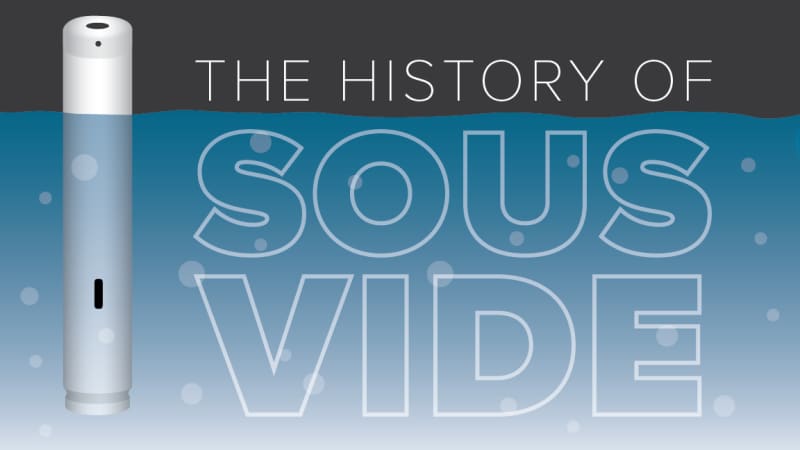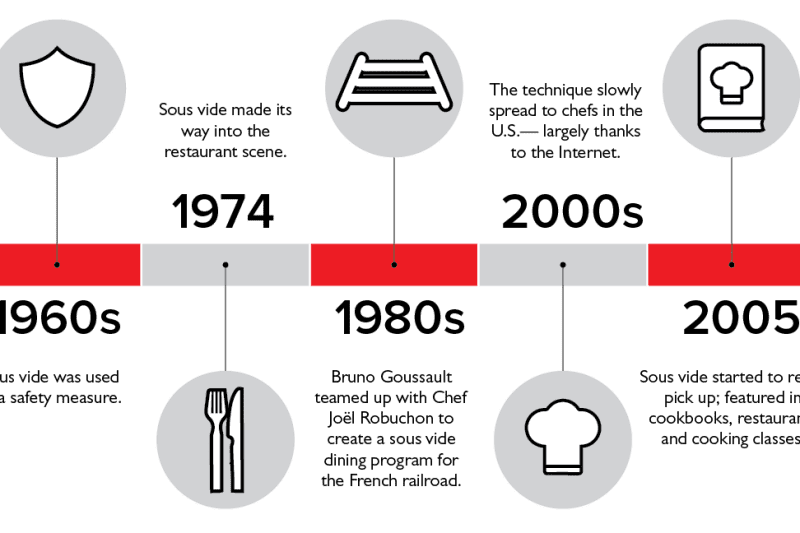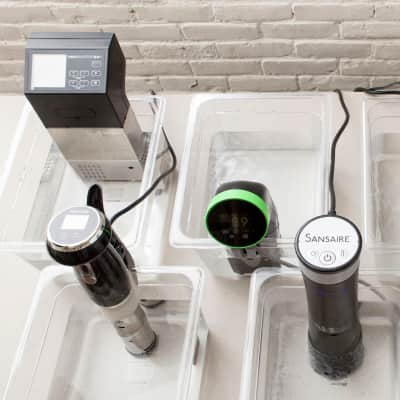Immersion circulators did not enter the market as a way to cook. Instead, they were first used as equipment in scientific laboratories. Precisely heated water baths are perfect for incubating live cell cultures and testing materials—and basically anything else you’d use a Bunsen burner for.
The History of Sous Vide, Explained
Published Aug. 28, 2018.

Sous Vide Machines (Immersion Circulators)
Sous vide machines are cheaper, sleeker, and smarter than ever before. Can we find one that brings this high-tech cooking technique into the mainstream?When sous vide arrived in the food world, the technique wasn’t initially used to make food taste better. In the late 1960s, when food-grade plastic films and vacuum packing were mastered by French and American engineers, sous vide was used as a safety measure: The ability to keep packaged foods in a water bath at a certain temperature made pasteurizing and sterilizing easier for labs, hospitals, and large-scale commercial food companies. Originally, vacuum packing and cooking foods sous vide was used to seal and pasteurize industrially prepared foods so that they would have a longer shelf life.
But then in 1974, sous vide made its way into the restaurant scene. (Well, kind of.) French chef Pierre Troisgros wanted to develop a new way to cook foie gras, and he hired Georges Pralus, another chef, to help. The goal? To lose as little fat as possible when cooking. After all, fat is flavor, and foie gras is all about fatty flavor. Through experimentation, Pralus found that the liver lost the least amount of fat when poached at a precise temperature, sealed in plastic.
Around the same time, Bruno Goussault—an economist, inventor, and chef—made similar discoveries for commercial food operations and hospitals. In the 1980s, he teamed up with Chef Joël Robuchon to create a sous vide dining program for the French railroad. This paved the way for Goussault’s next career move: He has been the chief scientist at Cuisine Solutions, an American company that specializes in sous vide food preparation and packaging, since 1989.
The technique slowly spread to chefs in the U.S.— largely thanks to the Internet. Chefs began to acquire sous vide circulators for their kitchens in the early 2000s. (Thomas Keller was one of the first.) The only problem: No one really knew how to use them. None of these chefs had come up in the kitchen world using them. No one had spent time experimenting with them. Enter: the website eGullet. The forums on this culinary-minded site were a place for people to geek out on food-related issues, and sous vide was a perfect subject.


Cutting-edge chefs like Chicago's Grant Achatz, Charleston's Sean Brock, and New York's Wylie Dufresne, and many others would talk about what they were playing with, and how they used different times and temperatures for different proteins.
In 2005, sous vide started to really pick up. Joan Roca, a chef in Spain, wrote a book about sous vide that arrived in the U.S. that year (with a slightly rocky translation). Chef Grant Achatz’s restaurant, Alinea, also opened—sous vide circulators included. Chef and inventor Dave Arnold began to teach low-temperature cooking classes at the French Culinary Institute.
“Cryovacking, which is more often called sous vide (French for “under vacuum”), is poised to change the way restaurant chefs cook,” wrote Amanda Hesser for the New York Times in a 2005 story called “Under Pressure.” “And like the Wolf stove and the immersion blender, it will probably trickle down to the home kitchen someday.”
In 2006, Dufresne battled Mario Batali on Iron Chef America; it was the first time sous vide circulators were seen on TV. The demand only grew from there.
The move into home kitchens has also been slow, and largely due to the influx of sous vide circulators with a lower price point, as professional devices cost over $1,000. In 2009, Sous Vide Supreme debuted as the first circulator for less than $500. In 2012, another sous vide circulator company called Nomiku launched, and they started selling machines for $359. In 2016, ChefSteps released their own circulator, called the Joule, for just $199. (In 2017, we named the Joule our top pick for the home cook.)


